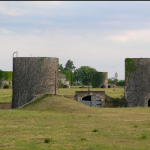[box] [featured]The planned redevelopment of the McMillan Sand Filtration Plant will create the city’s largest new park and foster a vibrant and walkable neighborhood. The transformation of this decommissioned industrial site will sensibly complement the surrounding neighborhoods of Bloomingdale and Stronghold and bring the isolated Washington Hospital Center campus back into the city’s fabric.
[featured]The planned redevelopment of the McMillan Sand Filtration Plant will create the city’s largest new park and foster a vibrant and walkable neighborhood. The transformation of this decommissioned industrial site will sensibly complement the surrounding neighborhoods of Bloomingdale and Stronghold and bring the isolated Washington Hospital Center campus back into the city’s fabric.
While the extensive planning process has built broad community support, the future of the former sand filtration site has been contested. Some who are opposing the transformation of this long off-limits city-owned parcel have mischaracterized the plans and are urging the DC government to halt progress despite the many proposed public benefits.[/featured][clear][/box]
[box][one-half]
Where We Are Today
Most of the development planned for McMillan received final approval from the DC Zoning Commission in September 2014. A second set of plans that weren’t as far along in design were presented to the DC Zoning Commission in June 2015. The District had parcels 6 & 7 approved in late May of 2016. This video shows the approved park design.
McMillan sand filtration site’s contractor is Vision McMillan Partners (VMP), a joint venture of Trammell Crow, EYA and Jair Lynch Real Estate Partners.
VMP held a groundbreaking event on December 7, 2016 at McMillan. But, on the next day, December 8, 2016, the DC Court of Appeals ordered that the Zoning Commission must vacate the historic preservation approvals for the site. The Court did not prohibit redevelopment, but sent the decision back to the city to explain why it was necessary to promote some policies and not others in the District’s Comprehensive Plan for land use planning decisions. However, the Court agreed that the McMillan project is consistent with policies in the Comprehensive Plan and Future Land Use Map.
We’ve been watching transportation management plans for the site over the past few years. Thanks to revisions to the plan in 2015, some of the outstanding transportation issues have been resolved. With the commitments the developers and the city have now agreed to, we believe that many visitors and residents at the McMillan site will have reliable, convenient options to come and go without needing a car – exactly the type of neighborhood we should be working to see more of in DC. [/one-half][one-half last]
Get Involved!
We will keep you updated on any opportunity to weigh in or take action.
[/one-half][line]
[one-half]
Action Alerts
- Tell DC City Council to say yes to McMillan Redevelopment (30 Oct 2014)
- Sign Up to Speak Out in Favor of the McMillan Redevelopment (24 Apr 2014)
- Speak Up for Moving McMillan Forward (4 Apr 2013)
- Support McMillan Redevelopment (17 Sep 2012)
[/one-half][one-half last]
Resources
Here are some additional resources to learn more about the new development at McMillan
- Check out the full plan and recent news at the Envision McMillan website
- CSG wrote a letter of support for the project to the DC Historic Preservation Review Board
[/one-half][clear][/box]
[box]
Traffic & Transportation Study
A transportation study from the Envision McMillan development team shows that the redevelopment can be done without choking the surrounding neighborhoods in traffic. Our main takeaway from the study? That it’s quite possible to make sure the McMillan redevelopment will provide a variety of transportation choices — not unnecessarily burden busy roads in the surrounding neighborhoods. This means following through on planned improvements to transit, which the report says are needed even if the site remains fenced off:
- In the short run, improving the Metrobus 80 bus line on North Capitol St. (already a designated bus priority corridor) will help the most.
- Other planned bus line improvements are recommended, along with the streetcar line running along Michigan Ave. from Woodley Park to Brookland Station.
- If these transit investments are delayed, the report recommends coordinated shuttles to the Brookland Metro station.
The study concludes that thanks to these new investments in transit and tweaks to the connecting roads, the traffic with the redevelopment will be no worse than if the redevelopment isn’t built. That’s great, and it shows how important more well-designed smart growth developments are to keeping residents mobile as DC continues to grow.
The report also calls for improvements to bicycling and pedestrian infrastructure including completing the street grid through McMillan, multiple pedestrian access points in each building, ample bicycle storage, and space for three Capital Bikeshare stations.[clear][line]
Places to Improve
While we think the study is positive overall, we’re not pleased with everything:
- We will need to press the city and DDOT to expedite transit investments. The city has been slower than it should in upgrading transportation choices elsewhere, so we will need to keep a close eye on the process.
- Ensuring good walking and bicycling conditions on and off the site deserves more attention. Busy driveways on Michigan Avenue pose potential new conflict points for pedestrians and bicyclists. As the city reviews this project, they should pay more attention to making the most of of the opportunity to improve access and safety in the area. Bicycling along Michigan Avenue is still a major concern, and while we applaud the suggestion of three Bikeshare stations, we’d like to see the development pay for at least one.
- The many new traffic signals proposed by the plan will be a help to pedestrians and bicyclists, but the added turn lanes and driveways on Michigan and 1st Street NW could pose additional barriers and hazards. We suggest that the builders provide stronger incentives to reduce how much driving is generated by the site, especially at rush hour when road capacity is used the most. The report suggests that later phases of the project can benefit by implementing incentives to reduce driving, lower vehicle parking ratios, and encourage transit use. We suggest strengthening these efforts now.
- The transportation plan specifically cites a proposed DC Circulator route from Brookland to Tenleytown – a route that covers the same ground as the current H buses. We suggest that instead of duplicating existing service, more attention is paid to improving the existing H bus lines. Metro recently studied the existing H bus services and made several important recommendations that can increase the speed and reliability of bus service through that corridor.
[clear][/box]
McMillan photo by dalesun on Flickr.



